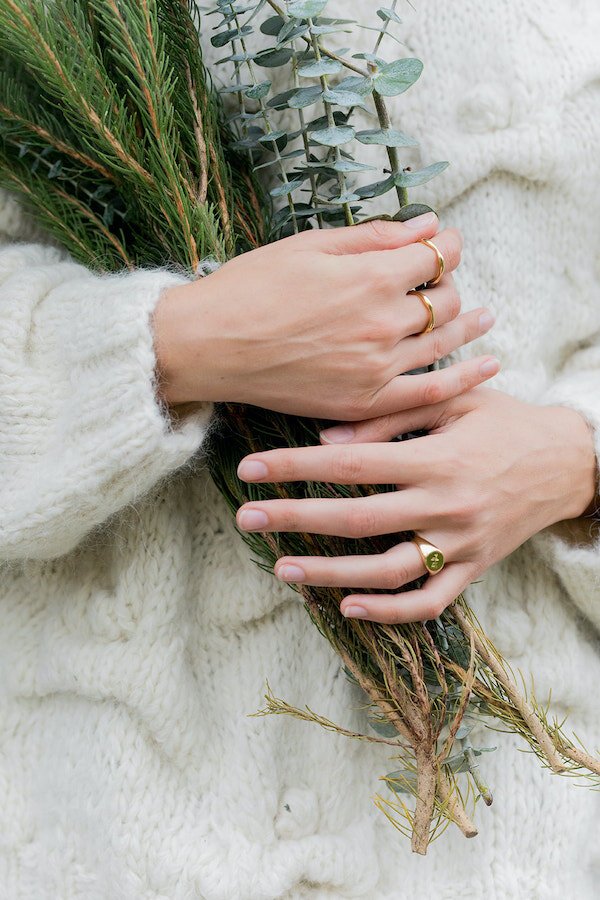
How Herbs And Plants Can Help Us Navigate Grief
Loss Hurts. Plants Can Help.
I’ve cried a lot this past year: on the walk to my job on an organic farm during the first weeks of stay-at-home instructions; after reading a tweet that equated the daily death toll from COVID to that of 9/11; most recently as I watched the first round of vaccines being administered. Grief traces a line through our histories. New loss can act as a tripwire, activating and allowing us to feel through many, or all, of the past moments of loss we’ve endured.
In this present moment marked by collective grief, we are not only processing the losses we feel as a result of COVID, but possibly the years of personal loss we’ve experienced in our own lives. When I let myself weep or get angry, I can tell that I’m dismayed by the current loss, exhaustion, and isolation we’re all experiencing, and my feelings are compounded by personal grief.
“In this present moment marked by collective grief, we are not only processing the losses we feel as a result of COVID, but possibly years of personal loss.”
New experiences of loss are painful, but they can also be a useful window into our past. As humans, we have a long history of surviving physical and emotional trauma, in part, because of our relationship to plants. Seeking help and healing from plants as we move through loss over days, weeks, months, and years can offer relief, comfort, and even strength. They can transform otherwise distressing events into opportunities to renew our commitment to healing and even help us to grow.
Below is a plant program for grief, appropriate for many kinds of loss. Though not a replacement for forms of therapy—I encourage my herbal clients to find a counselor with whom they can share their anger and sadness, even if it’s over the phone—it can serve as an additional aid to healing.
Each recipe includes a quick tea you can make, along with a practice that connects you to the world of plants, yourself, and others. May they help you feel connected even in times of distress.
As a general rule, look for certifications that might be important to you: organic, non-GMO, etc. Also, look for the country of origin, which should be listed on the packaging. This will tell you where the plant was grown and harvested. And if you want to buy domestically or locally, you can likely find growers in your region with a bit of poking around on the internet.
A note on sourcing plants: Look for local apothecary or herb shops in your area where you can buy dried leaves, flowers, and berries. If you want to shop online, Mountain Rose Herbs sources high-quality organic herbs and botanic goods.
Plants for the First Days of Grief:
Wood Betony + Skullcap
Brew a simple tea of ½ part wood betony and 1 part skullcap.
These two plants come from the mint family. Mints, in general, have a soothing effect on the nervous system. Since it’s hard to concentrate in the immediate aftermath of a loss, it’s common to feel frenzied and ungrounded. These feelings can often play out in difficulty concentrating and tending toward a compulsion to run away or disconnect from ourselves.
This simple tea delivers feelings of safety. It can help us find groundedness and alleviate a traumatized mind’s tendency to overthink and forego rest. The combination is safe enough to drink every day, multiple times a day, for as long as these feelings persist.
Plants for Weeks Into Grieving:
Motherwort
Make a tea with ½ part motherwort, 2 parts violet leaf or nettle leaf, 1 part cinnamon, and 1 part cardamom.
Motherwort’s affinity for the heart is present in its Latin name Leonurus cardiaca, which roughly translates to “lion hearted.” When grief shows up as rage or anger, we must find ways to roar. This plant is native to Europe and Asia but has naturalized in the United States. It is in the mint family, so once established, it grows abundantly and often in shaded areas.
“Motherwort can offer us strength and remedy the restlessness that persists.”
A couple of weeks into grieving, it’s common to feel pulled to skip past discomfort, seeking distraction from the loud voice that says, “I can’t do this.” As reality settles in, motherwort can offer us strength. It can remedy the restlessness that persists as its nutritive properties work to strengthen our hearts and our stomachs, building up the systems that sustain us.
Motherwort is pretty acrid, unlike other mints, which makes it a good ally when we’re working to develop a taste for bitter experiences. Since it is so strong, I like to pair it with cinnamon and cardamom.
Plants for Months Into Grieving:
Elderflower + Rose + Hawthorn
Simmer 1 tablespoon hawthorn berries in 2 cups of water for 15 minutes. Take your pot off the heat, add 2 teaspoons rose petals, and steep for 7 minutes. Strain off the plant material and stir in 1-2 tablespoons elderflower liqueur or syrup.
Mythology around the elder tree identifies it as a symbol of sorrow and death. It grows on the edge of the wild and the cultivated—on the perimeters of meadows, walkways, and roads— occupying a liminal space. My favorite elder tree squeezed itself in the small green space between my aunt’s driveway and neighbor’s fence in Massachusetts.
Elder can be helpful as an ally when we are teetering on the brink of acceptance. Combined with the protection of rose and hawthorn (uplifting medicines armed with thorns), this tea can help us find the strength to surrender and offer protection while we make space for healing to begin.
One way to take elder medicine is to make a trip to the liquor store for Elderflower liqueur. This tea can move our broken yet strengthened hearts into repair. I’m not suggesting you get wasted on St. Germaine, but make a decoction to mix it with.
A note on rose petals: Avoid fresh roses from the grocery store or deli; they have likely been sprayed with chemicals to control pests and disease. Opt instead for dried rose petals from a local or online apothecary.
Plants to Help with Long-Standing Grief:
Linden + Lemon Balm
Prepare a tea by boiling a cup of water and pouring it over 1 teaspoon each of dried linden (flowers and leaves) and lemon balm. Steep for 7-10 minutes and breathe deeply to receive the soothing aromatic qualities.
In the summer, usually June, linden flowers bloom on the trees that line busy avenues and boulevards. Their sweet scent floats just above our heads, detectable if you lift your nose into the air. Linden tastes as good as it smells. The same is true for lemon balm, which is part of the mint family but smells more like citrus. The two grow abundantly in places populated with people, and they both happen to be excellent medicines for exhaustion.
“Linden and lemon balm [are] excellent medicines for exhaustion.”
The cumulative effects of loss can leave us feeling fried, and an uplifting cup of linden and lemon balm can help shed the subtle remains of loss and restore vitality to our bodies. The moistening, cooling, and calming actions of linden and lemon balm can also quell the emotions ignited by an unexpected reminder of the loss.
Have you used plants for personal healing? 🍃 Share your experience in the comments below!
RELATED READING
Christine Buckley is the author of Plant Magic: Herbalism in Real Life. She is an artist, writer, and herbalist based in Florida.
